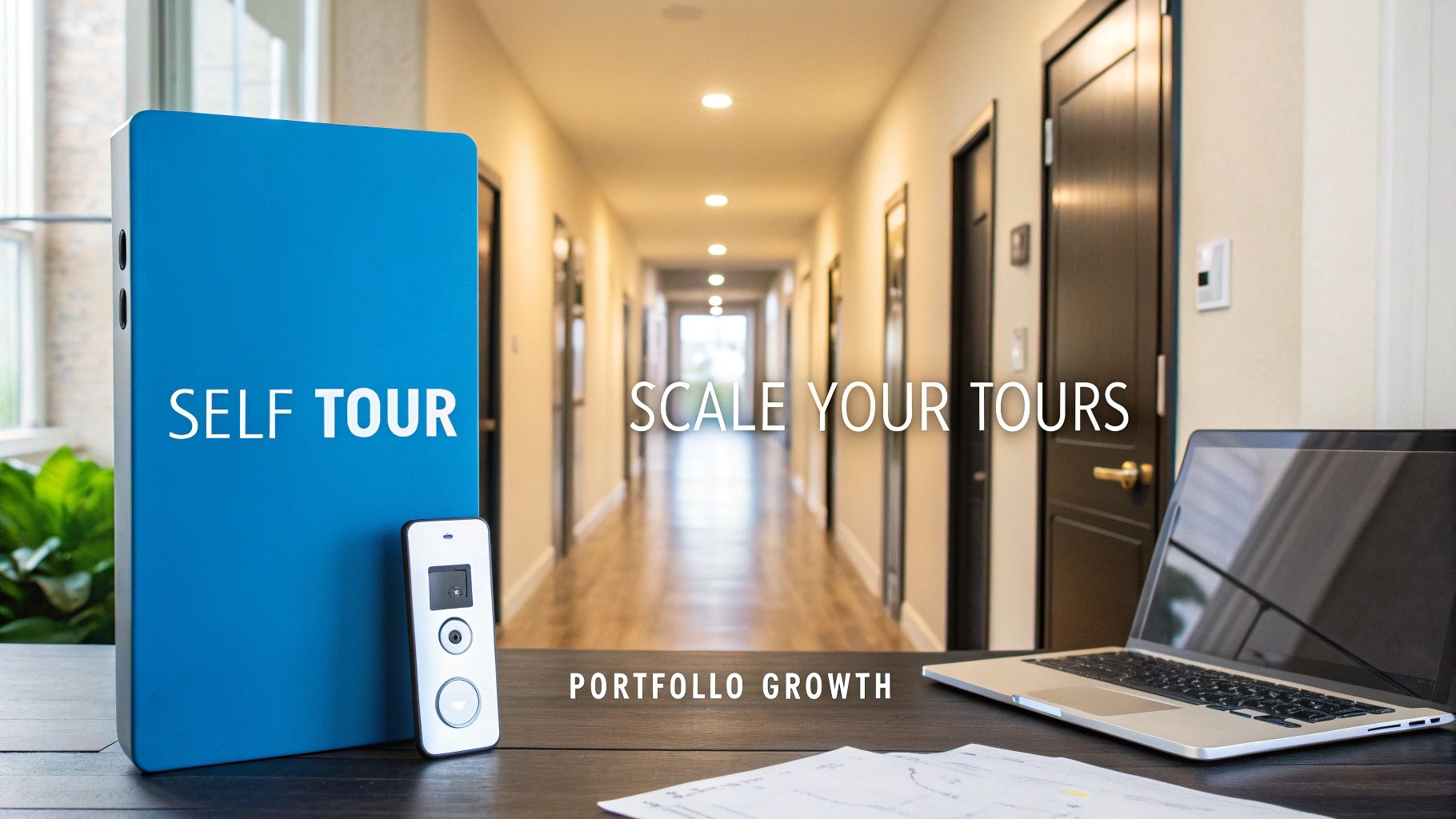For a large-scale property management company, a showing agent isn't just someone who unlocks a door. They are a specialized professional whose entire mission is to convert a qualified lead into a serious applicant by executing a flawless property tour. Think of them as the frontline representatives for your portfolio, completely focused on nailing that critical first impression and shrinking your Days on Market (DOM).
What a Showing Agent Means for Modern Property Management
When you're managing hundreds or even thousands of units spread across a city or multiple markets, the traditional model of a single leasing agent doing everything breaks down. It doesn’t scale. The logistics alone—coordinating tours across a scattered portfolio—create delays, cost you qualified leads, and directly drive up vacancy rates. Every vacant day is lost revenue, and this is precisely where a dedicated showing agent becomes a powerful operational and financial tool.

Your traditional leasing agent is a generalist, juggling marketing, applications, renewals, and a dozen other tasks. A showing agent, on the other hand, is a specialist with one job: to show properties quickly and professionally. This laser focus is what allows enterprise-level property management companies to meet the modern renter's demand for instant, same-day tours—a critical factor in converting hot leads before they lease from a competitor.
The Shift from Generalist to Specialist
This isn't a small tweak; it's a fundamental operational shift designed for scale. You're effectively unbundling the physical act of showing a property from the administrative work that follows. When you analyze the common use cases for property managers in large portfolios, it becomes clear why this specialization is vital for cost-per-door efficiency. Segmenting these roles allows you to optimize your entire leasing funnel for speed and conversion.
By implementing this model, property managers with large, distributed portfolios see immediate, measurable benefits:
- Drastic DOM Reduction: It's simple math. Faster tours lead to faster applications and lease signings. This means less revenue lost to vacancy across the portfolio.
- Higher Lead-to-Tour Conversion: When a prospect is interested, you have a small window to act. Offering immediate tour availability captures them at their peak interest, significantly boosting conversion rates.
- True Operational Scalability: Using an on-demand network, like the network of licensed agents available through Showdigs, means you can handle a surge in tour requests across multiple markets without the fixed overhead of hiring more full-time staff.
- A More Focused In-House Team: Your core leasing team eliminates "windshield time." Instead, they can focus on high-value work like nurturing qualified leads, processing applications, and closing deals faster.
A showing agent is a force multiplier for your leasing team. It’s how you deliver a standardized, professional experience for prospects across a wide geographic area while keeping your operations lean and efficient.
The Core Responsibilities of a High-Performing Showing Agent
A great showing agent is far more than a door opener. In a large-scale operation, they’re the engine that drives leasing velocity. Their entire role is structured around a single KPI: shrinking the time between a prospect’s initial inquiry and their decision to apply, which directly impacts your portfolio's revenue. They stay laser-focused on a handful of high-impact tasks and execute them with speed and precision.
This role is a unique blend of customer service, logistics, and on-the-ground intelligence. You don't measure their success in closed leases, but in how efficiently and effectively they convert leads into tours and tours into actionable feedback.
Mastering Tour Logistics and Property Presentation
The primary function of a showing agent is to manage a dynamic tour schedule, often across a wide geographic area. This isn't just about punctuality. It’s about optimizing routes, confirming appointments on the fly, and ensuring seamless property access.
Before a prospect arrives, the agent ensures the property is "show-ready." A quick check of lighting, temperature, and overall cleanliness creates a welcoming environment. Their goal is to present the property in its best light, highlighting features that matter to today's renters—like home office space, modern appliances, or smart home technology.
For enterprise portfolios, this standardization is everything. A showing agent guarantees that every prospect, whether viewing unit #10 or unit #1000, receives the same high-quality, professional tour that reinforces your brand's reputation.
Guiding Prospects and Gathering Actionable Feedback
During the tour, the agent acts as a knowledgeable guide, not a passive observer. They answer questions, build rapport, and frame the property’s features effectively. A simple walkthrough becomes a compelling narrative about why this should be the prospect's next home. This personal touch is a significant factor in boosting lead-to-tour conversion rates.
However, their most valuable contribution to a remote management team is the collection of immediate, unfiltered feedback. After every tour, they log the prospect's reactions, objections, and overall sentiment. This on-the-ground intelligence is invaluable. It provides real-time data to adjust pricing, refine marketing descriptions, or address minor maintenance issues that might be deterring applicants.
This specialized focus is incredibly efficient. A typical showing agent might spend only 20-30% of their time conducting tours; the rest is dedicated to communication and gathering crucial feedback. This process directly helps shorten the time a property sits on the market. According to the National Association of Realtors, real estate trends are constantly evolving, and speed-to-lease remains a critical competitive advantage.
By empowering showing agents to own this process, your core leasing team is freed up to focus on what they do best: negotiating leases and getting vacancies filled. The entire leasing funnel moves faster.
The Financial Impact of Using Showing Agents for Large Portfolios
If you’re overseeing a large portfolio, every operational decision must be justified by the numbers. Transitioning from a traditional, salaried leasing model to an on-demand network of showing agents isn't just a matter of convenience—it's a strategic financial decision to boost Net Operating Income (NOI) and reduce fixed overhead.
The value becomes undeniable when you analyze the cost-per-door and the direct revenue impact of vacancy loss.
A salaried leasing agent is a fixed cost. Whether they conduct five tours or fifty in a week, their salary, benefits, and vehicle expenses remain constant. This model becomes highly inefficient for distributed portfolios, where you end up paying for hours of drive time instead of valuable face-time with prospective tenants.
A showing agent network operates on a variable, pay-per-showing basis. You only incur costs when a tour is actively generating a potential lease—transforming a fixed operational expense into a flexible, scalable one. This aligns your spending directly with leasing activity, a more intelligent way to manage fluctuating demand across hundreds or thousands of units.
Calculating the ROI of Slashed Vacancy Days
The most significant financial gain comes from revenue recovery through reduced Days on Market (DOM). Every day a unit sits vacant is a direct financial loss. An on-demand agent network provides the operational speed to offer same-day showings, which is critical for converting high-intent leads before they sign a lease elsewhere.
Let's run a simple calculation for a 1,000-unit portfolio:
- Average Rent: $1,800/month (or $60/day)
- Average Vacancy Rate: 5% (50 vacant units at any given time)
- Daily Portfolio Vacancy Cost: 50 units x $60/day = $3,000 per day
Now, what if using an on-demand showing agent network could reduce your average time-to-lease by just five days? The reclaimed revenue is substantial:
- 5 days x $3,000/day = $15,000 in recovered revenue for each leasing cycle.
Annually, this can easily translate into hundreds of thousands of dollars flowing back to the portfolio's bottom line.
This chart illustrates how specialized agents focus their time on the high-impact activities that produce these results.

As you can see, their efforts are concentrated on high-value interactions—scheduling, touring, and collecting feedback—which directly accelerate the leasing timeline.
A Scalable Model Built for Growth
The economic impact of this specialization is significant. The Bureau of Labor Statistics (BLS) reported that the real estate sector, which includes showing agents, contributed over $180 billion to the U.S. economy in 2023. You can discover more insights about the role of agents and see how specialization drives value across the industry.
When you integrate a showing agent network into your operations, you are not just outsourcing a task. You are investing in a system that directly ties operational efficiency to financial performance. It’s a powerful lever for reducing vacancy costs and maximizing the NOI of your entire portfolio.
How Technology Empowers the Modern Showing Agent
In a large-scale property management operation, a showing agent is a critical node in a tech-driven leasing ecosystem. Property technology (PropTech) is what transforms the logistical challenge of manually coordinating tours into a streamlined, automated workflow that directly improves your key performance metrics.
This is about building a seamless, integrated system from initial lead capture to lease execution. The right technology stack elevates a showing agent from a tour guide into a powerful asset for filling vacancies faster across a distributed portfolio.

Essential Tools for the Modern Showing Agent
For property managers overseeing hundreds or thousands of scattered-site properties, the primary operational hurdles are speed and coordination. Technology provides the solution.
- Automated Scheduling Software: Best-in-class platforms integrate directly with your lead sources (e.g., Zillow, Apartments.com) and your core PMS. This allows prospective tenants to book tours instantly based on real-time availability, eliminating the phone tag that kills lead momentum.
- Mobile Apps for Intelligent Dispatch: A mobile-first platform is essential. It assigns agents based on proximity and availability, generates optimized driving routes, and delivers all necessary property and prospect information directly to their smartphone.
- Digital Feedback Platforms: Immediately following a tour, agents submit prospect feedback via their app. This data is instantly available to your central team, providing real-time insights to adjust pricing, marketing, or address property issues.
This level of technological integration is now the industry standard for scalable operations. Recent industry reports indicate that 85% of showing agents utilize digital scheduling software, which can reduce administrative tasks by up to 40%.
Gaining a Competitive Edge with Same-Day Showings
The single greatest competitive advantage delivered by a tech-enabled agent network is the ability to offer same-day showings.
High-intent renters expect an immediate response. If they must wait 24-48 hours for a tour, they will likely lease another property before your team can even respond. Technology closes this critical speed gap.
By automating the scheduling and dispatch process, you can convert a hot lead into an in-person tour in hours, not days. This is a massive advantage that directly reduces your Days on Market (DOM) and protects your rental income.
AI-powered tools amplify this efficiency. For example, an AI leasing assistant can pre-qualify leads and handle initial inquiries 24/7. This ensures only the most serious prospects are scheduled with your agents, maximizing the conversion potential of every tour.
Technology also enhances visual presentation. For prime examples, review these virtual staging before and after transformations. This combination of automation and on-demand agents creates a powerful, scalable leasing engine purpose-built for enterprise property management.
So, you're convinced of the operational and financial benefits of an on-demand showing agent network. Smart move. But how do you integrate it into your existing operations without causing disruption?
Let's be clear: this isn't about replacing your current system. It’s about a strategic operational upgrade. For property management companies managing large, distributed portfolios, the key is a phased, data-driven rollout. You need to prove the concept, minimize disruption, and achieve quick wins to build momentum.
The objective is to build a scalable system that enhances your leasing operations. The best approach is to start with the properties that present the biggest logistical challenges.
Start With a Strategic Pilot Program
Where do you begin? Identify your most operationally intensive units. For most large portfolios, this means your single-family rentals (SFRs) scattered across a wide geography. These properties consume the most "windshield time" for salaried agents, making them ideal candidates for an on-demand network.
Think of it as a controlled experiment. Here’s a simple framework for your pilot program:
- Select Your Pilot Portfolio: Choose a group of 25-50 scattered-site SFRs. This is the optimal size—large enough to generate meaningful data but small enough to manage closely.
- Define Success Metrics: Before launch, establish your Key Performance Indicators (KPIs). You must track metrics that directly impact your bottom line, such as lead response time, lead-to-tour conversion rate, and tour-to-application ratio.
- Integrate Your Technology: Ensure your showing platform integrates seamlessly with your existing Property Management System (PMS) and lead sources. API connectivity is crucial for automating scheduling and data flow, eliminating manual data entry.
Train Your Core Team and Get Ready to Scale
Integrating an on-demand network isn't about replacing your in-house leasing team; it's about elevating their function. Train your core staff to transition from tour coordinators to high-value leasing consultants. Their new focus should be on post-tour activities—nurturing qualified leads, processing applications, and closing leases.
Once your pilot program demonstrates tangible results—such as a measurable drop in Days on Market (DOM) and an improved tour-to-application rate—it's time to expand.
Let the data guide your rollout. Use the initial KPIs to build a solid business case for scaling the model across your entire portfolio. Begin with SFRs, then expand to multifamily properties that lack dedicated on-site staff. This methodical approach ensures buy-in and a smooth operational transition.
By following this strategic roadmap, you can integrate a network of showing agents in a controlled, measurable way. You'll transform leasing from a logistical bottleneck into a highly efficient, revenue-driving machine.
KPIs for Measuring Showing Agent Performance and ROI
For data-driven operators managing large portfolios, success is defined by metrics, not intuition. To measure the true impact a showing agent network has on your bottom line, you must track the right Key Performance Indicators (KPIs). Forget vanity metrics; focus on data that proves leasing acceleration and revenue enhancement.
Simply counting tours is insufficient. A sophisticated approach focuses on operational efficiency and conversion rates. These are the metrics that create a clear performance dashboard and justify operational investments.
Core Operational KPIs
First, analyze the top of your leasing funnel. How effectively are you converting initial interest into on-site tours?
- Lead-to-Tour Conversion Rate: This is your primary measure of top-of-funnel effectiveness. It answers a critical question: What percentage of qualified leads are successfully touring your properties? A low rate here signals friction in your scheduling process that is costing you opportunities.
- Average Time from Lead to Tour: In a competitive rental market, speed is paramount. This KPI tracks your response velocity. A shorter time—ideally measured in hours, not days—demonstrates that you are engaging serious prospects before competitors can.
Bottom-Line Impact KPIs
While operational speed is important, it must translate directly to financial results. These KPIs measure the quality and impact of the tours on your revenue cycle.
The most critical metric to track is your Tour-to-Application Rate. This KPI validates the effectiveness of your showings. A high rate indicates that your agents are showcasing properties effectively to well-qualified prospects who are ready to move forward.
Ultimately, these metrics should all contribute to one primary goal for any large-scale operator: a measurable reduction in Days on Market (DOM). Every day you eliminate from your average vacancy period translates directly into recovered rental income.
By linking improved operational KPIs to a lower DOM, you can calculate the precise financial ROI of your showing agent strategy.
Essential KPIs for Showing Agent Program Success
To effectively manage your showing agent program, you need a dashboard of metrics that provides a complete performance picture. Here is a breakdown of what large-scale operators should track to measure effectiveness and financial returns.
By monitoring these numbers, you transition from assumption-based management to a data-driven strategy. You can pinpoint exactly where your leasing process is excelling and where it needs optimization, ensuring your investment in a showing agent network delivers maximum returns.
For a deeper dive, see our guide on how to perform a comprehensive business health check with leasing metrics to further refine your approach.
Showing Agent FAQs
When we speak with operations directors and portfolio managers at large-scale companies, a few key questions consistently arise. If you're evaluating this model for the first time, you likely have the same questions. Let's address the most common ones.
How Does This Model Work for Multifamily vs. SFRs?
The model is a game-changer for both asset classes, with slightly different primary benefits.
For single-family rentals (SFRs) distributed across a wide geographic area, the value is immediate and obvious. An on-demand agent network eliminates "windshield time"—the unproductive hours your team spends driving between properties. This allows you to offer rapid, same-day showings across your entire portfolio without increasing fixed labor costs.
For multifamily buildings, particularly those without dedicated on-site staff, showing agents provide critical operational flexibility. You can cover showings during peak demand hours—evenings and weekends—without the overhead of additional payroll. The goal is to ensure every lead receives a prompt, professional tour, regardless of property type, location, or time of inquiry.
How Do I Maintain Quality Control with a Third-Party Network?
This is a critical question for any operator focused on brand consistency. Modern platforms are architected with quality control as a core feature. You are not blindly handing over keys; you are managing a data-driven process.
Here’s how you maintain control:
- Prospect Feedback: Post-tour surveys provide direct, unfiltered feedback on the prospect's experience with both the property and the agent.
- Performance Analytics: You can track key metrics such as agent ratings, tour-to-application rates, and adherence to specific showing instructions.
- Digital Reporting: Agents submit photos and notes directly from the property via a mobile app, confirming the unit is secure and show-ready for the next tour.
Do Showing Agents Replace My In-House Leasing Team?
Absolutely not. They amplify your team's effectiveness.
Think of it this way: a showing agent network handles the high-volume, logistical component of conducting tours. This liberates your expert in-house leasing consultants to focus on high-value, revenue-generating activities.
Instead of coordinating schedules and driving across town, they can build relationships with qualified prospects, diligently process applications, and close leases. They transition from being generalist tour coordinators to dedicated closing specialists, which dramatically accelerates your entire leasing cycle from lead to lease.
Ready to see how an on-demand network of showing agents can slash your Days on Market and boost your portfolio's revenue? Showdigs provides the smart platform and vetted agent network to automate your leasing funnel from first look to final lease. Schedule a demo today and we'll help you calculate your potential ROI.






